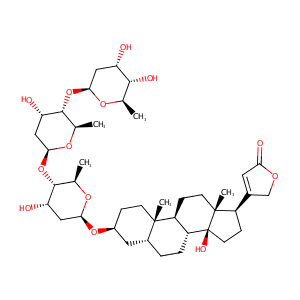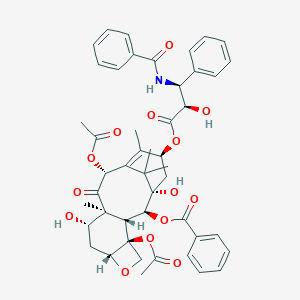| 1 |
Recurrent recessive mutation in deoxyguanosine kinase causes idiopathic noncirrhotic portal hypertension.Hepatology. 2016 Jun;63(6):1977-86. doi: 10.1002/hep.28499. Epub 2016 Mar 31.
|
| 2 |
URL: http://www.guidetopharmacology.org Nucleic Acids Res. 2015 Oct 12. pii: gkv1037. The IUPHAR/BPS Guide to PHARMACOLOGY in 2016: towards curated quantitative interactions between 1300 protein targets and 6000 ligands. (Ligand id: 6782).
|
| 3 |
Paclitaxel directly binds to Bcl-2 and functionally mimics activity of Nur77. Cancer Res. 2009 Sep 1;69(17):6906-14.
|
| 4 |
Drugs@FDA. U.S. Food and Drug Administration. U.S. Department of Health & Human Services. 2015
|
| 5 |
Clinical pipeline report, company report or official report of the Pharmaceutical Research and Manufacturers of America (PhRMA)
|
| 6 |
Clinical pipeline report, company report or official report of the Pharmaceutical Research and Manufacturers of America (PhRMA)
|
| 7 |
Treatment of congestive heart failure--current status of use of digitoxin. Eur J Clin Invest. 2001;31 Suppl 2:10-7.
|
| 8 |
The association of ABCB1 polymorphisms and elevated serum digitoxin concentrations in geriatric patients. Eur J Clin Pharmacol. 2008 Apr;64(4):367-72.
|
| 9 |
Species differences in the toxicity and cytochrome P450 IIIA-dependent metabolism of digitoxin. Mol Pharmacol. 1991 Nov;40(5):859-67.
|
| 10 |
Use of a human liver microsome bank in drug glucuronidation studies. Toxicol In Vitro. 1991;5(5-6):559-62.
|
| 11 |
Hydroxysteroid sulfotransferase and a specific UDP-glucuronosyltransferase are involved in the metabolism of digitoxin in man. Naunyn Schmiedebergs Arch Pharmacol. 1992 Aug;346(2):226-33.
|
| 12 |
Heterogeneous transport of digitalis-like compounds by P-glycoprotein in vesicular and cellular assays. Toxicol In Vitro. 2016 Apr;32:138-45. doi: 10.1016/j.tiv.2015.12.009. Epub 2015 Dec 17.
|
| 13 |
Digitoxin elicits anti-inflammatory and vasoprotective properties in endothelial cells: Therapeutic implications for the treatment of atherosclerosis? Atherosclerosis. 2009 Oct;206(2):390-6.
|
| 14 |
Digitoxin and a synthetic monosaccharide analog inhibit cell viability in lung cancer cells. Toxicol Appl Pharmacol. 2012 Jan 1;258(1):51-60. doi: 10.1016/j.taap.2011.10.007. Epub 2011 Oct 18.
|
| 15 |
Digitoxin mimics gene therapy with CFTR and suppresses hypersecretion of IL-8 from cystic fibrosis lung epithelial cells. Proc Natl Acad Sci U S A. 2004 May 18;101(20):7693-8. doi: 10.1073/pnas.0402030101. Epub 2004 May 10.
|
| 16 |
Digitoxin promotes apoptosis and inhibits proliferation and migration by reducing HIF-1 and STAT3 in KRAS mutant human colon cancer cells. Chem Biol Interact. 2022 Jan 5;351:109729. doi: 10.1016/j.cbi.2021.109729. Epub 2021 Oct 28.
|
| 17 |
Biologically active neutrophil chemokine pattern in tonsillitis.Clin Exp Immunol. 2004 Mar;135(3):511-8. doi: 10.1111/j.1365-2249.2003.02390.x.
|
|
|
|
|
|
|


